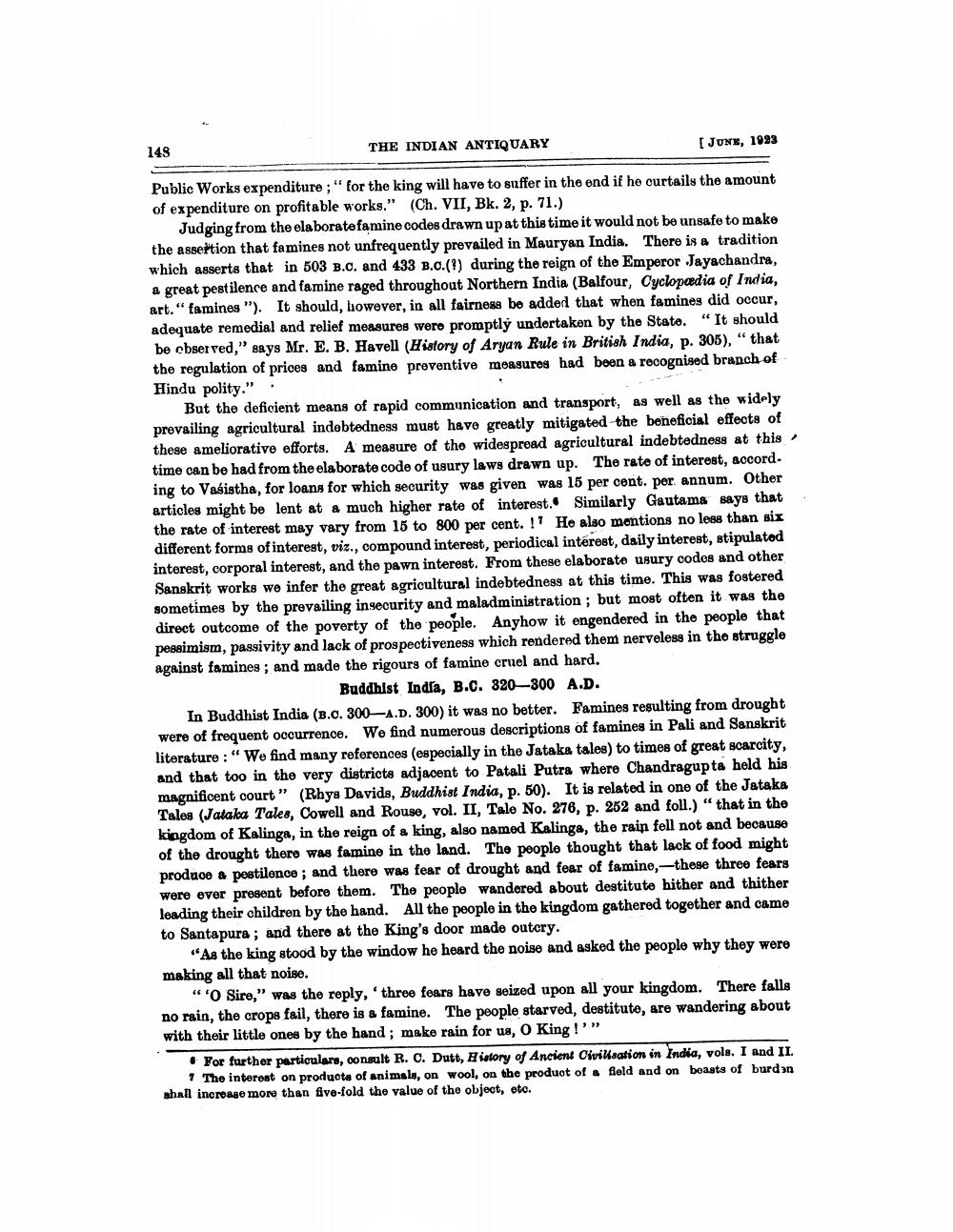________________
143
THE INDIAN ANTIQUARY
[Jonx, 1923
Public Works expenditure ;" for the king will have to suffer in the end if he curtails the amount of expenditure on profitable works." (Ch. VII, Bk. 2, p. 71.)
Judging from the elaborate famine codes drawn up at this time it would not be unsafe to make the assertion that famines not unfrequently prevailed in Mauryan India. There is a tradition which asserts that in 603 B.c. and 433 B.O.(8) during the reign of the Emperor Jayachandra, a great pestilence and famine raged throughout Northern India (Balfour, Cyclopædia of India, art." famines"). It should, however, in all fairness be added that when famines did occur, adequate remedial and relief measures were promptly undertaken by the State." It should be cbserved,” says Mr. E. B. Havell (History of Aryan Rule in British India, p. 305), " that the regulation of prices and famine preventive measures had been a recognised branch of Hindu polity" :
But the deficient means of rapid communication and transport, as well as the widely prevailing agricultural indebtedness must have greatly mitigated the beneficial effects of these ameliorative efforts. A measure of the widespread agricultural indebtedness at this time can be had from the elaborate code of usury laws drawn up. The rate of interest, accord. ing to Vaśistha, for loans for which security was given was 15 per cent. per annum. Other articles might be lent at a much higher rate of interest. Similarly Gautama says that the rate of interest may vary from 15 to 800 per cent. !' He also montions no less than six different forms of interest, viz., compound interest, periodical interest, daily interest, stipulated interest, corporal interest, and the pawn interest. From these elaborate usury codes and other Sanskrit works we infer the great agricultural indebtedness at this time. This was fostered sometimes by the prevailing insecurity and maladministration ; but most often it was the direct outcome of the poverty of the people. Anyhow it engendered in the people that pessimism, passivity and lack of prospectiveness which rendered them nerveless in the struggle against famines; and made the rigours of famine cruel and hard.
Buddhist India, B.C. 820—300 A.D. In Buddhist India (B.C. 300-A.D. 300) it was no better. Famines resulting from drought were of frequent occurrence. Wo find numerous descriptions of famines in Pali and Sanskrit literature : "We find many references (especially in the Jataka talos) to times of great scarcity, and that too in the very districts adjacent to Patali Putra where Chandragupta held his magnificent court” (Rhys Davids, Buddhist India, p. 50). It is related in one of the Jataka Tales (Jataka Tales, Cowell and Rouse, vol. II, Tale No. 276, p. 262 and foll.) “that in the kingdom of Kalinga, in the reign of a king, also named Kalinga, the rain fell not and because of the drought there was famine in the land. The people thought that lack of food might produce a pestilence; and there was fear of drought and fear of famine,-these three fears were over present before them. The people wandered about destituto hither and thither leading their children by the hand. All the people in the kingdom gathered together and came to Santapura ; and there at the King's door made outcry.
"As the king stood by the window he heard the noise and asked the people why they were making all that noise.
“'O Sire," was the reply, 'three fears have seized upon all your kingdom. There falls no rain, the crops fail, there is a famine. The people starved, destituto, are wandering about with their little ones by the hand; make rain for us, o King!'"
• For further particulars, consult R. O. Dutt, History of Ancient Civilisation in India, vole. I and II
1 The interest on products of animals, on wool, on the produot of flold and on boasts of burdən ahal increase more than five-fold the value of the object, etc.




